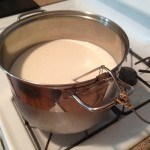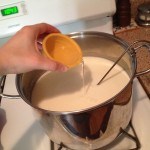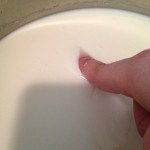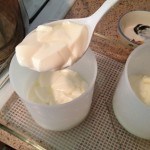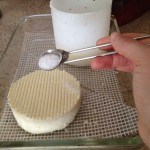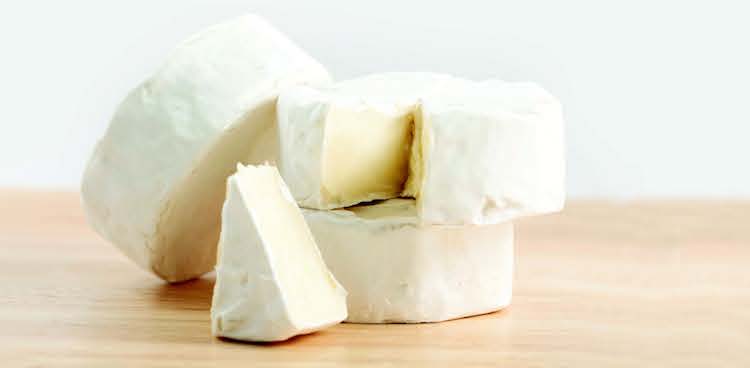
Legend has it that camembert was first made in the 1790s by a farmer’s wife named Marie Harel, who learned the recipe from a priest from Brie. While these origins are disputed, the delectableness of the cheese is not. And today, with some care and a few pieces of equipment, you can make camembert in your own home.
The only differences between camembert and brie are 3°F during acidification (which occurs at 85°F for camembert and 88°F for brie) and the shape of the molds (4 inches for camembert and 7½ inches across for brie). Traditionally, both cheeses are made from whole milk, but for richer versions you can double the amount of cream.
Once you’ve successfully made a camembert, you can start experimenting with brie or Saint André. While brie requires a differently sized mold, you can use painter’s tape to stack two camembert molds to fill in as the one, taller mold that’s needed for Saint André. Then just fill the double-height mold with twice as much curd as you’d need for camembert.
Makes 2 4-inch rounds of camembert
SUPPLIES:
- Nonreactive pot with lid, large enough to comfortably hold at least 1 gallon of milk
- Thermometer, clipped to the pot’s rim but not touching its sides or bottom
- 2 small bowls, each large enough to hold at least 1/4 cup liquid
- Large skimmer (a large stirring spoon may be substituted)
- Knife, long enough to reach the bottom of the pot
- Measuring cups
- Measuring spoons
- Kitchen timer
- 2 camembert molds
- Ripening containers with lids
- Mats for each ripening container
- Plastic wrap or aluminum foil
INGREDIENTS:
- Distilled water, at room temperature
- ⅛ teaspoon calcium chloride (CaCl2) solution
- ¼ teaspoon liquid calf rennet
- 1 gallon skim milk, minus 11.2 ounces
- 11.2 ounces heavy cream (choose a brand that doesn’t contain carrageenan)
- ⅛ teaspoon mesophilic II culture (thawed to room temperature)
- 1/16 teaspoon Penicillium candidum mold powder/li>
- 2 teaspoons cheese salt (noniodized)
- Cheese paper
Step 1
Add ¼ cup distilled water to each small bowl. Dissolve the CaCl2 in one of the cups, and dissolve the rennet in the other.
Step 2
Pour the skim milk and heavy cream into the pot, and mix well. Slowly warm the milk to 85°F. Sprinkle the mesophilic II culture and Penicillium candidum powder over the milk, and let stand 5 minutes.
Step 3
Use the skimmer to “bottom stir,” or stir from the bottom to the top rather than swirling in a circle, trying not to break the surface of the mixture. Cover the pot, and let ripen for 10 minutes at 85°F.
Step 4
Pour the diluted CaCl2 solution over the mixture, and bottom stir until well mixed. Pour in the dissolved rennet solution, and bottom stir. Cover the pot with the lid, and let stand at 85°F for 1½ hours.
Step 5
Check for a “clean break” by inserting the clean handle of a spoon or a finger into the curd at a 45-degree angle. If the curd splits apart in a clean line, you have achieved a clean break. If not, let it stand for another 10 minutes or more, until a clean break is achieved.
Step 6
Using a long knife, make a set of vertical cuts parallel to each other about one inch apart. Then, make a second set of cuts perpendicular to the first set to create 1-by-1-inch curd columns. Use the skimmer to make the final horizontal cuts, working your way around the pot in 1-inch steps from the top to the bottom. Let the cubed curds stand for 5 minutes to firm.
Step 7
Use the skimmer to gently lift curds every 30 to 60 seconds. Pull curds to the top of the pot, but leave them submerged in the whey. Within 2 to 10 minutes, they will begin to shrink and to develop rounded corners.
Step 8
Set up two molds on top of two draining mats in a sterilized location at room temperature (68 to 72°F.). Use a measuring cup to discard whey from the pot, until curds are just below the surface of the whey. Use the skimmer to fill molds with curd. Let stand 2 hours.
Step 9
Flip each mold: Place a clean draining mat on top of each mold, gently slide a hand under the mat below each mold, and carefully flip. After 2 hours, flip again, and cover with plastic or foil to keep the wheels from drying out. Leave 8 hours or overnight. In the morning flip again, and leave for 2 hours.
Step 10
Remove the cheeses from the molds, and sprinkle the top of each with ½ teaspoon salt. Flip and repeat on the other side. Place the cheeses in ripening containers on mats in an environment where you can keep them for 4 to 5 weeks, and where the temperature stays between 50 and 55°F. On a daily basis, empty any water that has collected under the mats and flip the cheeses. When mold completely covers each (in 12 to 20 days), wrap each in cheese paper and move to the cave for continued aging. The cheeses will begin to soften at 20 days, and they are ready to eat after 4 to 5 weeks.
- Step 2. Slowly warm the milk to 85°F.
- Step 4. Pour the diluted CaCl2 solution over the mixture
- Step 4. Bottom stir without breaking the surface to mix
- Step 5. Check for a “clean break” by inserting the clean handle of a spoon or a finger into the curd at a 45-degree angle
- Step 8. Use the skimmer to fill molds with curd
- Step 8. Let the curd drain for 2 hours before flipping
- Step 10. 10. Remove the cheeses from the molds, and sprinkle the top of each with ½ teaspoon salt


